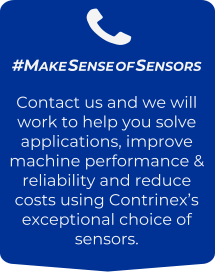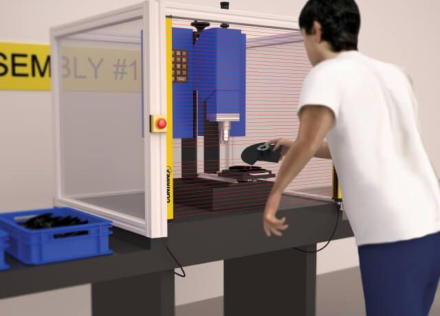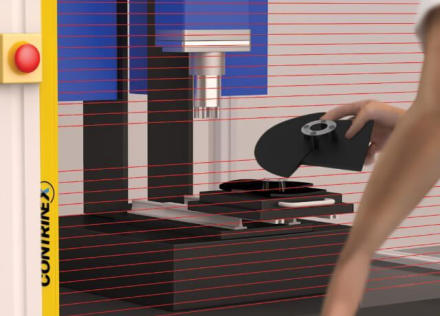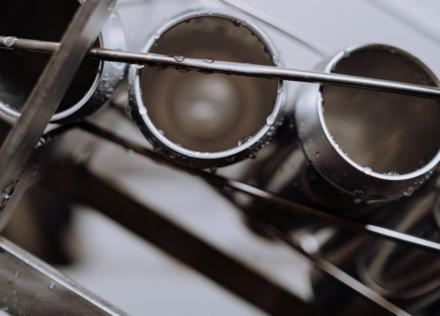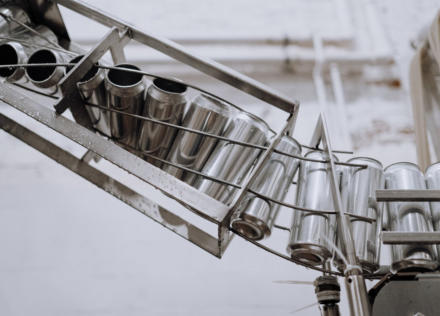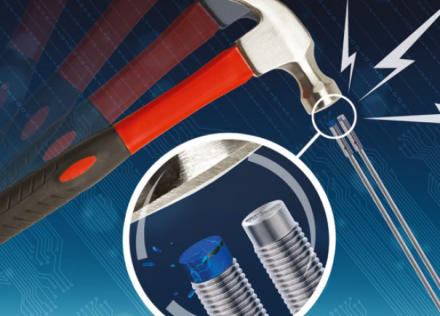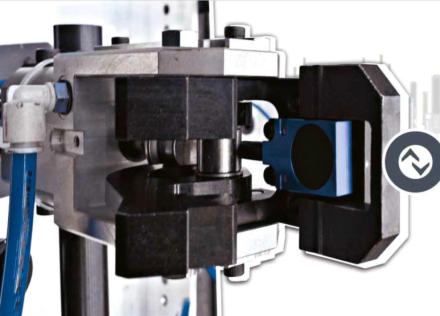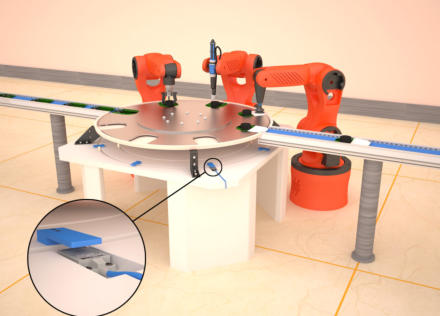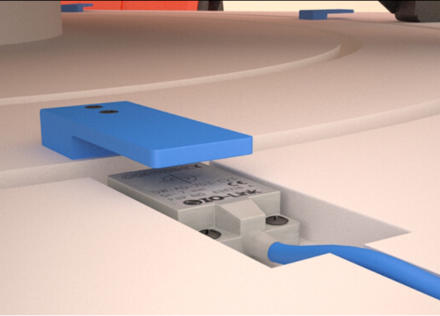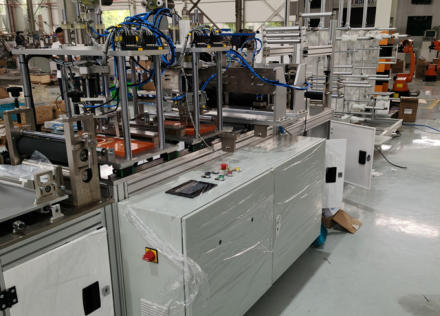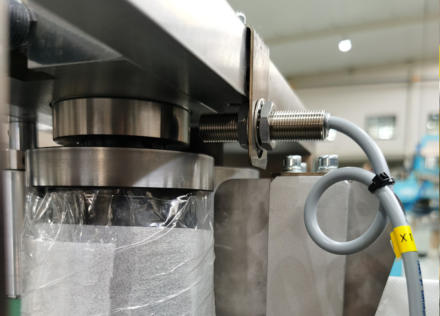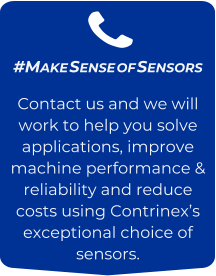(0121) 58 222 58 SALES@PLUSAUTOMATION.CO.UK

© 2021 - PLUS Automation Limited®

HELPING YOU #MAKE SENSE OF SENSORS




EXAMPLE APPLICATIONS
TO ILLUSTRATE THE WIDE-VARIETY OF APPLICATIONS SOLVED USING CONTRINEX SENSORS, WE HAVE POSTED A LARGE SELECTION OF EXAMPLE APPLICATIONS WHICH CAN BE SEEN BY CLICKING ON AN IMAGE. BELOW ARE A SELECTION OF SOME OF THESE APPLICATIONS:



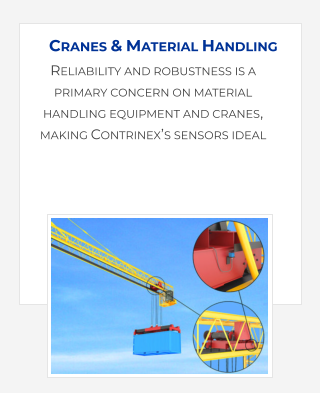
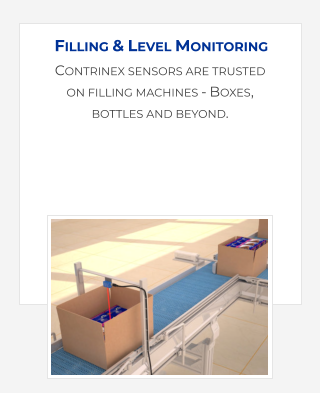
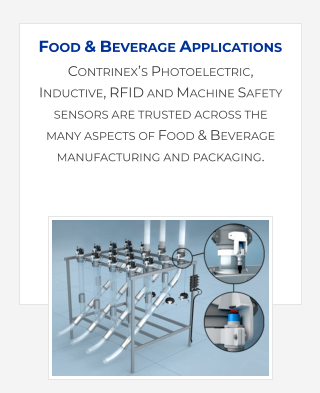
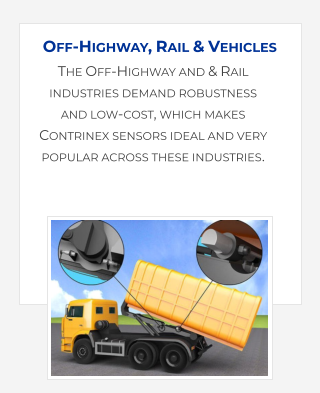
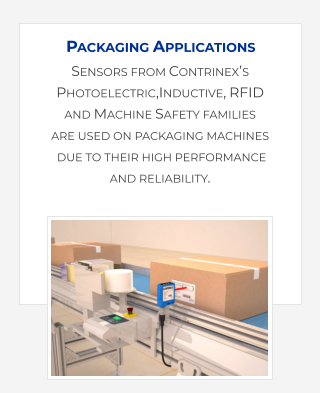
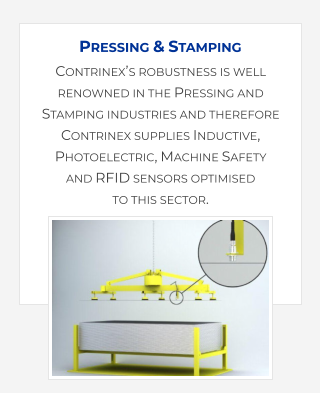
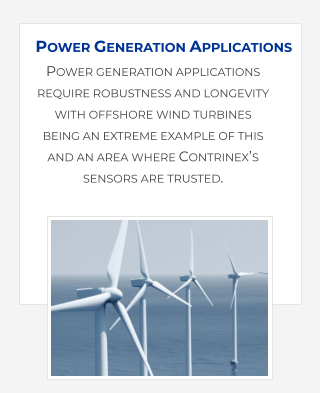
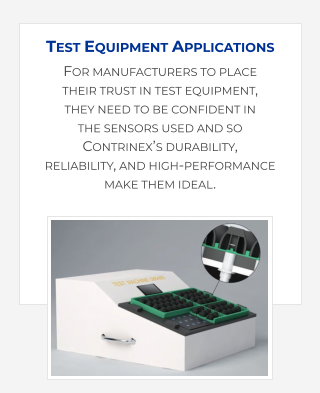

CUSTOMER VALUES
COST-EFFECTIVE, ACTIVE SAFEGUARDING
IMPROVED WORKPLACE ERGONOMICS
INCREASED PRODUCTIVITY ARISING FROM UNIMPEDED
LOADING AND UNLOADING
INDUSTRY-STANDARD INTERFACE REQUIRES MINIMAL
MODIFICATION TO CONTROL SYSTEMS
PRODUCT ADVANTAGES
PERMANENT AUTOCONTROL NOT USUALLY FOUND ON TYPE 2
SAFETY DEVICES
IP65 AND IP67 PROTECTION
NON-CONTACT OPERATING PRINCIPLES
EXCELLENT SAFETY RATING TO EN/ISO 13849-1 CAT. 2 PL C
AND IEC 61508 SIL 1
AOPD (ACTIVE OPTOELECTRONIC PROTECTIVE DEVICE) WITH
ALUMINIUM HOUSING AND M12 CABLE CONNECTOR
CUSTOMER SOLUTION
The company’s risk assessment confirms that Type 2 AOPDs
(active optoelectronic protective devices) would ensure
appropriate operator protection. Designed for applications
where the risk has been evaluated as moderate, Safetinex IEC
61496 Type 2 light curtains from Contrinex are rated to EN/ISO
13849-1 Category 2, Performance Level PL c and IEC 61508
Safety Integrity Level SIL 1, making them ideal for the
application.
The heat-staking press is housed in an open-fronted enclosure
with clear impact-resistant walls. The light curtain has an
operating range of up to 12 metres and a resolution of 30 mm,
ideal for hand protection; it safeguards the open front area of
the press, allowing easy access when required. The protected
height is 795mm, ensuring safe operation without impeding
the operator during loading and unloading.
Manufactured with rugged extruded aluminium housings and
IP65 + IP67 protection, these units are well-suited to the
production environment and will withstand shocks and
vibrations.
Industry-standard PNP normally-open configuration allows
connection to the customer’s control system via an integral 5-
pin M12 cable connector. These units have an integrated
alignment LED and permanent autocontrol – a feature not
usually found on Type 2 safety devices.
The new sensors take up much less space than the
mechanical guards they replaced, improving workplace
ergonomics. Loading and unloading is no longer impeded,
increasing productivity while actively safeguarding operators.
Safetinex Type 2 light curtains provide a reliable and cost-
effective solution.
During semi-automated heat staking of assemblies
manufacturers use light curtains to preserve operator safety
without compromising production throughput. The active
optoelectronic protective device (AOPD), mounted directly in
front of each bench-mounted heat-press, prevents the press-
head from descending if it detects any intrusion in the
working area, halting the operating cycle immediately.
CUSTOMER APPLICATION
Heat-staking is a popular process for fastening metal parts to
plastic moldings, and is commonly used by manufacturers
during the production of sub-assemblies. At each station, an
operator loads a molding and one or more metal parts into a
slide-mounted assembly fixture. Once the components are
correctly inserted, the operator pushes the slide into position
beneath the press-head, triggering the automated heat-
staking cycle.
The heated press-head, which may reach temperatures in
excess of 350oC (660oF), descends toward the pre-positioned
components. It applies heat and pressure to specific areas of
the molding, causing a controlled thermal deformation that
creates a permanent joint between the metal parts and the
molding. Following a pre-determined dwell period, the head
returns to the raised position, ending the cycle; the operator
withdraws the slide and removes the assembly from the
fixture.
Existing mechanical safety barriers are cumbersome and
inconvenient; throughput is constrained as a result of the time
taken to open and close the guards during each cycle. The
company requires an alternative safety guard that provides
effective hand protection while allowing unobstructed loading
and unloading. It must be simple, space-saving and operate
reliably in the production environment.

CUSTOMER VALUES
HIGHLY COST EFFECTIVE SOLUTION - SUBSTANTIALLY LOWER
COST THAN OTHER DOUBLE-SHEET DETECTION SOLUTIONS
SIMPLE SETUP AND USE
ELIMINATES MACHINE JAMS, BREAKAGE OF TOOLING AND SO
ELIMINATES PRODUCTION DOWNTIME
CORROSION-RESISTANT SENSORS WITHSTAND CLEANING
PRODUCT ADVANTAGES
UNIQUE TECHNOLOGY DEFIES LIMITS OF TRADITIONAL
INDUCTIVE SENSOR TECHNOLOGY
EXTREMELY ROBUST, IMPACT AND ABRASION RESISTANT IP68/
IP69K STAINLESS-STEEL RATED HOUSING
CORROSION-RESISTANT, V2A/ AISI 304 STAINLESS-STEEL,
FOOD-COMPATIBLE BODY
IO-LINK INTERFACE INCLUDED – IDEAL FOR INDUSTRY 4
A manufacturer of metal cans needs to ensure that the press
that applies and crimps the bottom onto the can body is fed
with only one bottom. Therefore a fast, non-contact and robust
checking mechanism is required.
CUSTOMER APPLICATION
A conveyor with a stainless-steel glide plate backed by a
permanent magnet ensures that the can bottoms travel
perfectly flat on the belt which transports them to the
assembly stage. If double-bottoms are fed into the assembly
stage, damage can be done to the press, tools can be broken,
and even the press becoming jammed will cause production
downtime.
To check that only one bottom is being fed to the assembly
stage whilst they are attached magnetically to the fast-moving
belt, requires a non-contact sensing solution. The thin gauge
of steel used to produce the can bottoms (~0.33 mm thick) is
too small for the customer’s normal automatic double-sheet
detector to work reliably.
CUSTOMER SOLUTION
Contrinex’s Extreme 700 Series sensors provide a robust and
simple, cost effective solution. They utilise their Condet®
technology to detect the mass of a target by inducing a
voltage in it, whereas a traditional inductive sensor would
induce the voltage only in the target’s surface.
The stainless-steel bodied sensor (DW-Ax-70X-M12) is mounted
approximately 4 – 5 mm above the dome of a can bottom. On
its own, the 0.33mm thick steel doom presents insufficient
mass to switch the sensor at this distance, however the
presence of a second bottom piece increases target mass
sufficiently to switch the sensor.
The inductive sensor triggers a rejection shoot whenever two
bottoms are detected as being stacked together and so
provide a robust and reliable system to protect the assembly
press.
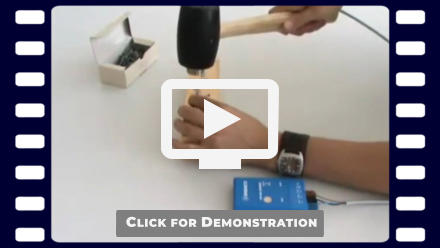
AUTOMATED ASSEMBLY ENSURES FAULT-FREE ASSEMBLY AND CONTRINEX SENSORS
ARE TRUSTED FOR THEIR RELIABILITY ESPECIALLY AS COMPLEXITY INCREASES.
CONTRINEX’S LARGE AND INNOVATIVE PRODUCT PORTFOLIOS PROVIDE CHOICE IN SENSING
TECHNOLOGIES AND HOUSING DESIGNS AND SIZES. ASSEMBLY EQUIPMENT MANUFACTURERS
TYPICALLY VALUE MINIATURISATION, ROBUSTNESS, LONG-SENSING RANGES AND PERFORMANCE.
ASSEMBLY EQUIPMENT APPLICATIONS

WATCH THE VIDEO TO SEE THE UNIQUE
ROBUSTNESS SURVIVE A HAMMERING

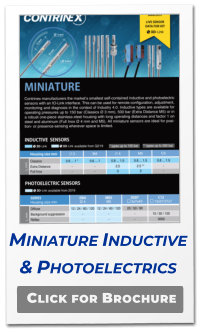

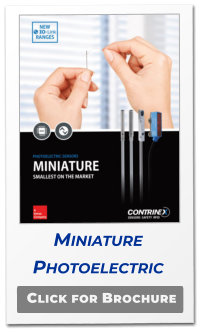
Conveyors deliver a continuous stream of parts to the rotary
indexing table, which transports them in sequence to each
assembly station. As the table rotates, sensors located at
precise intervals around its periphery detect its exact angular
position, bringing it to a halt once parts are correctly
positioned for the next operation.
At each assembly station, automated pick-and-place
equipment add components to the assembly. Dedicated
transport mechanisms – including vacuum lifters,
electromagnetic clamps and mechanical grippers – insert
items swiftly and accurately in their designated positions.
Embeddable inductive sensors play a key role in confirming
the secure closure of custom-designed grippers before fragile,
high-value parts are lifted.
Manufactured in V4A/ AISI 316L stainless steel and rated to
IP68/ IP69K, these small inductive sensors can be fully
embedded into a steel surface such as part of the rotary table
or an assembly jig or bench, further reducing the potential for
mechanical damage.
On completion of the final assembly stage, finished PCBs are
discharged to a linear conveyor system. They travel to
subsequent processing stages, including testing and packing.
C23 Full Inox sensors mounted directly above these conveyors,
detect each unit as it passes below. This check not only
confirms the presence of the assembled item at the expected
height above the conveyor but also measures throughput by
activating a counting circuit in the customer’s control system.
Continuous operation is the norm in automated assembly
plants. However, minor adjustments or tool changes may be
required from time to time. In non-safety-critical areas, access
hatches allow maintenance technicians to carry out these
tasks without needing to interrupt production across an entire
plant. Multiple sensors, mounted at intervals around the
periphery of a hatch, ensure that appropriate warning signals
are activated whenever the opening is not fully secured.
The Contrinex C23 series of Full Inox inductive sensors have the
capability of communicating remotely with a plant-wide
control system, thanks to the implementation of the IO-Link
protocol. In a typical automated plant, each assembly line runs
continuously throughout the day, with remote diagnostics
eliminating the need for manual intervention in almost every
situation.
Designed to simplify integration, IO-Link sensors are
compatible with all IO-Link master versions, allowing set-up
and diagnostics to be conducted centrally. Interrogating a
device returns its manufacturer ID and product ID, allowing
systems integrators to determine remotely that the right
sensor is in the correct location. Contrinex C23 inductive
sensors additionally feature an on-demand self-test function
that confirms full capability at all times.
For the C23 inductive series, alternating between normally
open and normally closed functionality via remote output-
mode configuration is a standard feature of the IO-Link
protocol. Systems designers also can modify the output signal.
Delaying the switching pulse accommodates any travel time
between a sensor and its corresponding actuation point, while
stretching the pulse ensures that slave devices with lengthy
response times trigger reliably, even at high throughput rates.
Finally, each sensor provides an output-status check derived
from its factory calibration data. If the output signal from a
sensor falls outside a range that corresponds to a sensing
distance between 80% and 100% of its nominal value, an alarm
flag is triggered, highlighting the need for investigation. For
plant managers under pressure, peace-of-mind is a valuable
benefit.
The no-cost option of the industry-standard IO-Link protocol
ensures that best-in-class performance is coupled with
ultimate ease of use in even the most demanding
circumstances.

CUSTOMER VALUES
EFFICIENT, FAULT-FREE ASSEMBLY.
NO SENSOR-RELATED DOWNTIME.
DIGITAL COMMUNICATION WITHOUT NEEDING SPECIAL
CABLING.
OUTSTANDING PROCESS MONITORING & CONTROL
CAPABILITIES.
FAST, EASY SET-UP AND RECONFIGURATION.
PRODUCT ADVANTAGES
EXTREMELY ROBUST, IMPACT AND ABRASION RESISTANT IP68/
IP69K RATED HOUSING.
CORROSION-RESISTANT, V4A/ AISI 316L STAINLESS-STEEL,
FOOD-COMPATIBLE BODY ON C23 AND AVAILABLE AS AN
OPTION ON CYCLINDRICAL SENSORS.
LONG OPERATING DISTANCE OF 7MM IN A SMALL & SLIM
STAINLESS-STEEL 20X 32X 8MM HOUSING.
ROBUST, METAL-CASED INDUCTIVE PROXIMITY SENSORS
SUITABLE FOR EASY INTEGRATION
FACTOR 1 - CONSISTENT SENSING, IRRESPECTIVE OF WHETHER
THE TARGET IS STEEL OR ALUMINIUM.
RELIABLE, COMPACT VIBRATION-RESISTANT SENSORS
IO-LINK INTERFACE INCLUDED – IDEAL FOR INDUSTRY 4
Fault-free assembly is ensured, downtime minimised and
assembly speed increased by using automated facilities for
high volume assembly. Rugged inductive sensors detect the
presence and position of equipment or components at each
stage to ensure that parts are correctly aligned and ready for
the next operation. The sensors must be accurate and
responsive. In addition, an IO-Link interface offers the
advantages of digital communication without the need for
special cabling.
CUSTOMER APPLICATION
Highly reliable automation and machine-control systems are
used to eliminate assembly faults and improve efficiency in an
assembly operation. Whilst the repetitive assembly tasks are
well-suited to being done by robots, these robots can be too
slow at picking and placing the assembled parts and therefore
a rotary indexing table is used to move the assemblies
between the robots.
The rotary indexing table speeds up the transfer of PCBs
between assembly robots and also on and off conveyors,
increasing the production throughput and reducing the
number of assembly robots required – Sensors are used to
automate these processes and these sensors must be able to
operate continuously at high speed, performing tasks
including: presence detection to initiate the cassette-change
cycle in a stack feeder; position control for a rotary indexing
table; pick-and-place gripper control; and presence monitoring
on a conveyor system.
Customer Solution
Stack-feeders deliver base plates, electrical printed circuit
boards and other planar components to the assembly lines. In
each stack-feeder, a vertical cassette holds as many as 50
individual parts and a single inductive sensor monitors the
status of each cassette. Once the final part is discharged from
the stack, the cassette moves to its end position, triggering the
sensor and initiating the cassette-change cycle.
Contrinex C23 embeddable inductive sensors, featuring a one-
piece stainless-steel housing, are both robust and highly
reliable. A 7mm sensing distance allows ample operating
clearance, minimizing the risk of mechanical collision. Their
implementation into the assembly equipment is made easier
by the choice of industry-standard PNP or NPN outputs with
either a PUR cable or an M8 pigtail connector. Additionally, IO-
Link, a standardised point-to-point serial connection protocol
for sensors and actuators, is provided at no additional cost,
offering the advantages of digital communication without the
need for special cabling, making them ideal for Industry 4
applications.
Designed for demanding applications, Contrinex’s rugged C23
inductive sensors offer best-in-class switching frequency of
180Hz and exceptional robustness including impact and
abrasion resistance, making them a versatile, cost-effective
and highly reliable solution. These uniquely robust sensors are
typically demonstrated by Contrinex as being able to
repeatedly being used to hammer in nails. Even when their
front face is dented, the sensor continues to operate correctly

CUSTOMER VALUES
RUGGED INDUCTIVES ENSURE ACCURATE POSITIONING OF
MATERIALS, ELIMINATING FAULTS
MINIATURE EXTRA-DISTANCE SENSOR FITS SAFELY &
UNOBTRUSIVELY INTO IN-LINE WELDING STATION
IMMEDIATE AVAILABILITY OF DIVERSE SENSOR RANGE
ENABLES RAPID INCREASE IN PRODUCTION CAPACITY
PROVEN TECHNOLOGY ENSURES HIGHLY RELIABLE FIT-&-
FORGET OPERATION WITH NO MANUAL INTERVENTION
PRODUCT ADVANTAGES
ROBUST, METAL-CASED INDUCTIVE PROXIMITY SENSORS
SUITABLE FOR EASY INTEGRATION
DIVERSE PORTFOLIO OFFERS EXCEPTIONAL RANGE OF SIZES
AND SENSING DISTANCES
RELIABLE, COMPACT VIBRATION-RESISTANT SENSORS
IO-LINK INTERFACE INCLUDED FOR FREE – IDEAL FOR
INDUSTRY 4
OEM equipment builders have long relied on Contrinex as a
single source of high-performance and reliable sensors for
integration within their machines. The ability to supply the
sensors from stock was also essential in this instance, as the
machine was built to manufacture essential N95 face masks.
The sensors synchronise material feeds in the machine during
the assembly process and ensure the part-completed mask is
positioned correctly. Designers specified rugged inductive
sensors with IO-Link connectivity to prevent costly machine
malfunctions.
CUSTOMER APPLICATION
Reliability is essential in automated production, and nowhere
more than in the hard-pressed healthcare supply sector. At the
time of the global COVID-19 crisis, OEM equipment builders
rushed to increase capacity for producing personal protective
equipment (PPE). Manufacturers of N95 face masks, a high-
volume item of PPE, faced unprecedented demand worldwide.
While a single N95 mask is a relatively low-cost item, fast-
moving production lines mean that any interruption to
continuous operation is disproportionately expensive. Machine
malfunctions not only cause lost production time but also
result in costly manual intervention, and must be prevented.
Purpose-built machines for manufacturing N95 masks must
dovetail several material feeds prior to assembly; they must
also ensure that part-completed masks are positioned
correctly during the process. Successive workstations
incorporate multiple position-sensing and presence-detection
sensors that monitor the status of material feeds and cutter
position, as well as checking part alignment for welding and
printing. It is highly desirable to source these devices from a
single manufacturer, minimizing spares inventory and
ensuring a common interface throughout an entire machine.
Customer Solution
OEM designers specified rugged inductive sensors from the
Contrinex Basic and Miniature ranges. Not only did the
available selection match the functional requirement exactly,
the immediate availability of all the required devices from
stock eliminated delays in ramping up capacity. All the
specified sensors feature IO-Link connectivity, providing a
single, industry-standard interface to the machine control
system.
Contrinex inductive sensors are designed with the needs of
OEMs and system integrators in mind and provide an
unobtrusive fit-and-forget solution. With a sensing distance of
4 mm, the two metal-cased M12 sensors used to monitor the
positions of the steel fabric cutter and the printing head are
robust and reliable. The M8 device that detects the feed
position of the aluminium fixing strip has a V2A stainless-steel
housing and an extended sensing distance of 2 mm, fitting
snugly in the limited space available.
The extra-distance miniature M5 sensor fitted at the welding
station has a nickel-silver housing and was selected because of
its 2.5-mm sensing distance, eliminating any danger of
accidental collision during operation. Connection to all the
specified sensors is via a PVC-sheathed cable with a 3-pin
connector or 2-metre flying lead; alternative lengths are
available.
These highly versatile sensors meet designers’ needs for
trouble-free operation using sensors from a single
manufacturer. The solution is highly reliable, cost-effective
and, critically, available without delay, allowing the immediate
increase in machine-building capacity required by the OEM
customer.

WATCH THE VIDEO TO SEE THE UNIQUE
ROBUSTNESS DEMONSTRATED
WATCH THE VIDEO OF A MINIATURE
PHOTOELECTRIC PREVENT CALCULATOR THEFT
WELCOME TO PLUS AUTOMATION LTD - EXPERTS IN SENSORS, WE WILL WORK TO HELP YOU
SOLVE YOUR APPLICATIONS, IMPROVE MACHINE PERFORMANCE & RELIABILITY AND REDUCE COSTS
USING CONTRINEX’S EXCEPTIONAL SENSORS - LET US HELP YOU #MAKE SENSE OF SENSORS






CUSTOMER VALUES
COST-EFFECTIVE, ACTIVE SAFEGUARDING
IMPROVED WORKPLACE ERGONOMICS
INCREASED PRODUCTIVITY ARISING FROM UNIMPEDED
LOADING AND UNLOADING
INDUSTRY-STANDARD INTERFACE REQUIRES MINIMAL
MODIFICATION TO CONTROL SYSTEMS
PRODUCT ADVANTAGES
PERMANENT AUTOCONTROL NOT USUALLY FOUND ON TYPE 2
SAFETY DEVICES
IP65 AND IP67 PROTECTION
NON-CONTACT OPERATING PRINCIPLES
EXCELLENT SAFETY RATING TO EN/ISO 13849-1 CAT. 2 PL C
AND IEC 61508 SIL 1
AOPD (ACTIVE OPTOELECTRONIC PROTECTIVE DEVICE) WITH
ALUMINIUM HOUSING AND M12 CABLE CONNECTOR
CUSTOMER SOLUTION
The company’s risk assessment confirms that Type 2 AOPDs
(active optoelectronic protective devices) would ensure
appropriate operator protection. Designed for applications
where the risk has been evaluated as moderate, Safetinex IEC
61496 Type 2 light curtains from Contrinex are rated to EN/ISO
13849-1 Category 2, Performance Level PL c and IEC 61508
Safety Integrity Level SIL 1, making them ideal for the
application.
The heat-staking press is housed in an open-fronted enclosure
with clear impact-resistant walls. The light curtain has an
operating range of up to 12 metres and a resolution of 30 mm,
ideal for hand protection; it safeguards the open front area of
the press, allowing easy access when required. The protected
height is 795mm, ensuring safe operation without impeding
the operator during loading and unloading.
Manufactured with rugged extruded aluminium housings and
IP65 + IP67 protection, these units are well-suited to the
production environment and will withstand shocks and
vibrations.
Industry-standard PNP normally-open configuration allows
connection to the customer’s control system via an integral 5-
pin M12 cable connector. These units have an integrated
alignment LED and permanent autocontrol – a feature not
usually found on Type 2 safety devices.
The new sensors take up much less space than the
mechanical guards they replaced, improving workplace
ergonomics. Loading and unloading is no longer impeded,
increasing productivity while actively safeguarding operators.
Safetinex Type 2 light curtains provide a reliable and cost-
effective solution.

CUSTOMER VALUES
HIGHLY COST EFFECTIVE SOLUTION - SUBSTANTIALLY LOWER
COST THAN OTHER DOUBLE-SHEET DETECTION SOLUTIONS
SIMPLE SETUP AND USE
ELIMINATES MACHINE JAMS, BREAKAGE OF TOOLING AND SO
ELIMINATES PRODUCTION DOWNTIME
CORROSION-RESISTANT SENSORS WITHSTAND CLEANING
PRODUCT ADVANTAGES
UNIQUE TECHNOLOGY DEFIES LIMITS OF TRADITIONAL
INDUCTIVE SENSOR TECHNOLOGY
EXTREMELY ROBUST, IMPACT AND ABRASION RESISTANT IP68/
IP69K STAINLESS-STEEL RATED HOUSING
CORROSION-RESISTANT, V2A/ AISI 304 STAINLESS-STEEL,
FOOD-COMPATIBLE BODY
IO-LINK INTERFACE INCLUDED – IDEAL FOR INDUSTRY 4
A manufacturer of metal cans needs to ensure that the press
that applies and crimps the bottom onto the can body is fed
with only one bottom. Therefore a fast, non-contact and robust
checking mechanism is required.
CUSTOMER APPLICATION
A conveyor with a stainless-steel glide plate backed by a
permanent magnet ensures that the can bottoms travel
perfectly flat on the belt which transports them to the
assembly stage. If double-bottoms are fed into the assembly
stage, damage can be done to the press, tools can be broken,
and even the press becoming jammed will cause production
downtime.
To check that only one bottom is being fed to the assembly
stage whilst they are attached magnetically to the fast-moving
belt, requires a non-contact sensing solution. The thin gauge
of steel used to produce the can bottoms (~0.33 mm thick) is
too small for the customer’s normal automatic double-sheet
detector to work reliably.
CUSTOMER SOLUTION
Contrinex’s Extreme 700 Series sensors provide a robust and
simple, cost effective solution. They utilise their Condet®
technology to detect the mass of a target by inducing a
voltage in it, whereas a traditional inductive sensor would
induce the voltage only in the target’s surface.
The stainless-steel bodied sensor (DW-Ax-70X-M12) is mounted
approximately 4 – 5 mm above the dome of a can bottom. On
its own, the 0.33mm thick steel doom presents insufficient
mass to switch the sensor at this distance, however the
presence of a second bottom piece increases target mass
sufficiently to switch the sensor.
The inductive sensor triggers a rejection shoot whenever two
bottoms are detected as being stacked together and so
provide a robust and reliable system to protect the assembly
press.
ASSEMBLY EQUIPMENT
APPLICATIONS
AUTOMATED ASSEMBLY ENSURES FAULT-FREE
ASSEMBLY AND CONTRINEX SENSORS ARE
TRUSTED FOR THEIR RELIABILITY ESPECIALLY
AS COMPLEXITY INCREASES.
CONTRINEX’S LARGE AND INNOVATIVE PRODUCT
PORTFOLIOS PROVIDE CHOICE IN SENSING
TECHNOLOGIES AND HOUSING DESIGNS AND SIZES.
ASSEMBLY EQUIPMENT MANUFACTURERS TYPICALLY
VALUE MINIATURISATION, ROBUSTNESS, LONG-
SENSING RANGES AND PERFORMANCE.
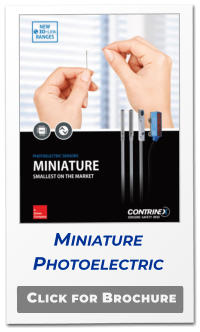
Conveyors deliver a continuous stream of parts to the rotary
indexing table, which transports them in sequence to each
assembly station. As the table rotates, sensors located at
precise intervals around its periphery detect its exact angular
position, bringing it to a halt once parts are correctly
positioned for the next operation.
At each assembly station, automated pick-and-place
equipment add components to the assembly. Dedicated
transport mechanisms – including vacuum lifters,
electromagnetic clamps and mechanical grippers – insert
items swiftly and accurately in their designated positions.
Embeddable inductive sensors play a key role in confirming
the secure closure of custom-designed grippers before fragile,
high-value parts are lifted.
Manufactured in V4A/ AISI 316L stainless steel and rated to
IP68/ IP69K, these small inductive sensors can be fully
embedded into a steel surface such as part of the rotary table
or an assembly jig or bench, further reducing the potential for
mechanical damage.
On completion of the final assembly stage, finished PCBs are
discharged to a linear conveyor system. They travel to
subsequent processing stages, including testing and packing.
C23 Full Inox sensors mounted directly above these conveyors,
detect each unit as it passes below. This check not only
confirms the presence of the assembled item at the expected
height above the conveyor but also measures throughput by
activating a counting circuit in the customer’s control system.
Continuous operation is the norm in automated assembly
plants. However, minor adjustments or tool changes may be
required from time to time. In non-safety-critical areas, access
hatches allow maintenance technicians to carry out these
tasks without needing to interrupt production across an entire
plant. Multiple sensors, mounted at intervals around the
periphery of a hatch, ensure that appropriate warning signals
are activated whenever the opening is not fully secured.
The Contrinex C23 series of Full Inox inductive sensors have the
capability of communicating remotely with a plant-wide
control system, thanks to the implementation of the IO-Link
protocol. In a typical automated plant, each assembly line runs
continuously throughout the day, with remote diagnostics
eliminating the need for manual intervention in almost every
situation.
Designed to simplify integration, IO-Link sensors are
compatible with all IO-Link master versions, allowing set-up
and diagnostics to be conducted centrally. Interrogating a
device returns its manufacturer ID and product ID, allowing
systems integrators to determine remotely that the right
sensor is in the correct location. Contrinex C23 inductive
sensors additionally feature an on-demand self-test function
that confirms full capability at all times.
For the C23 inductive series, alternating between normally
open and normally closed functionality via remote output-
mode configuration is a standard feature of the IO-Link
protocol. Systems designers also can modify the output signal.
Delaying the switching pulse accommodates any travel time
between a sensor and its corresponding actuation point, while
stretching the pulse ensures that slave devices with lengthy
response times trigger reliably, even at high throughput rates.
Finally, each sensor provides an output-status check derived
from its factory calibration data. If the output signal from a
sensor falls outside a range that corresponds to a sensing
distance between 80% and 100% of its nominal value, an alarm
flag is triggered, highlighting the need for investigation. For
plant managers under pressure, peace-of-mind is a valuable
benefit.
The no-cost option of the industry-standard IO-Link protocol
ensures that best-in-class performance is coupled with
ultimate ease of use in even the most demanding
circumstances.

CUSTOMER VALUES
EFFICIENT, FAULT-FREE ASSEMBLY.
NO SENSOR-RELATED DOWNTIME.
DIGITAL COMMUNICATION WITHOUT NEEDING SPECIAL
CABLING.
OUTSTANDING PROCESS MONITORING & CONTROL
CAPABILITIES.
FAST, EASY SET-UP AND RECONFIGURATION.
PRODUCT ADVANTAGES
EXTREMELY ROBUST, IMPACT AND ABRASION RESISTANT IP68/
IP69K RATED HOUSING.
CORROSION-RESISTANT, V4A/ AISI 316L STAINLESS-STEEL,
FOOD-COMPATIBLE BODY ON C23 AND AVAILABLE AS AN
OPTION ON CYCLINDRICAL SENSORS.
LONG OPERATING DISTANCE OF 7MM IN A SMALL & SLIM
STAINLESS-STEEL 20X 32X 8MM HOUSING.
ROBUST, METAL-CASED INDUCTIVE PROXIMITY SENSORS
SUITABLE FOR EASY INTEGRATION
FACTOR 1 - CONSISTENT SENSING, IRRESPECTIVE OF WHETHER
THE TARGET IS STEEL OR ALUMINIUM.
RELIABLE, COMPACT VIBRATION-RESISTANT SENSORS
IO-LINK INTERFACE INCLUDED – IDEAL FOR INDUSTRY 4
Fault-free assembly is ensured, downtime minimised and
assembly speed increased by using automated facilities for
high volume assembly. Rugged inductive sensors detect the
presence and position of equipment or components at each
stage to ensure that parts are correctly aligned and ready for
the next operation. The sensors must be accurate and
responsive. In addition, an IO-Link interface offers the
advantages of digital communication without the need for
special cabling.
CUSTOMER APPLICATION
Highly reliable automation and machine-control systems are
used to eliminate assembly faults and improve efficiency in an
assembly operation. Whilst the repetitive assembly tasks are
well-suited to being done by robots, these robots can be too
slow at picking and placing the assembled parts and therefore
a rotary indexing table is used to move the assemblies
between the robots.
The rotary indexing table speeds up the transfer of PCBs
between assembly robots and also on and off conveyors,
increasing the production throughput and reducing the
number of assembly robots required – Sensors are used to
automate these processes and these sensors must be able to
operate continuously at high speed, performing tasks
including: presence detection to initiate the cassette-change
cycle in a stack feeder; position control for a rotary indexing
table; pick-and-place gripper control; and presence monitoring
on a conveyor system.
Customer Solution
Stack-feeders deliver base plates, electrical printed circuit
boards and other planar components to the assembly lines. In
each stack-feeder, a vertical cassette holds as many as 50
individual parts and a single inductive sensor monitors the
status of each cassette. Once the final part is discharged from
the stack, the cassette moves to its end position, triggering the
sensor and initiating the cassette-change cycle.
Contrinex C23 embeddable inductive sensors, featuring a one-
piece stainless-steel housing, are both robust and highly
reliable. A 7mm sensing distance allows ample operating
clearance, minimizing the risk of mechanical collision. Their
implementation into the assembly equipment is made easier
by the choice of industry-standard PNP or NPN outputs with
either a PUR cable or an M8 pigtail connector. Additionally, IO-
Link, a standardised point-to-point serial connection protocol
for sensors and actuators, is provided at no additional cost,
offering the advantages of digital communication without the
need for special cabling, making them ideal for Industry 4
applications.
Designed for demanding applications, Contrinex’s rugged C23
inductive sensors offer best-in-class switching frequency of
180Hz and exceptional robustness including impact and
abrasion resistance, making them a versatile, cost-effective
and highly reliable solution. These uniquely robust sensors are
typically demonstrated by Contrinex as being able to
repeatedly being used to hammer in nails. Even when their
front face is dented, the sensor continues to operate correctly.

CUSTOMER VALUES
RUGGED INDUCTIVES ENSURE ACCURATE POSITIONING OF
MATERIALS, ELIMINATING FAULTS
MINIATURE EXTRA-DISTANCE SENSOR FITS SAFELY &
UNOBTRUSIVELY INTO IN-LINE WELDING STATION
IMMEDIATE AVAILABILITY OF DIVERSE SENSOR RANGE
ENABLES RAPID INCREASE IN PRODUCTION CAPACITY
PROVEN TECHNOLOGY ENSURES HIGHLY RELIABLE FIT-&-
FORGET OPERATION WITH NO MANUAL INTERVENTION
PRODUCT ADVANTAGES
ROBUST, METAL-CASED INDUCTIVE PROXIMITY SENSORS
SUITABLE FOR EASY INTEGRATION
DIVERSE PORTFOLIO OFFERS EXCEPTIONAL RANGE OF SIZES
AND SENSING DISTANCES
RELIABLE, COMPACT VIBRATION-RESISTANT SENSORS
IO-LINK INTERFACE INCLUDED FOR FREE – IDEAL FOR
INDUSTRY 4
OEM equipment builders have long relied on Contrinex as a
single source of high-performance and reliable sensors for
integration within their machines. The ability to supply the
sensors from stock was also essential in this instance, as the
machine was built to manufacture essential N95 face masks.
The sensors synchronise material feeds in the machine during
the assembly process and ensure the part-completed mask is
positioned correctly. Designers specified rugged inductive
sensors with IO-Link connectivity to prevent costly machine
malfunctions.
CUSTOMER APPLICATION
Reliability is essential in automated production, and nowhere
more than in the hard-pressed healthcare supply sector. At the
time of the global COVID-19 crisis, OEM equipment builders
rushed to increase capacity for producing personal protective
equipment (PPE). Manufacturers of N95 face masks, a high-
volume item of PPE, faced unprecedented demand worldwide.
While a single N95 mask is a relatively low-cost item, fast-
moving production lines mean that any interruption to
continuous operation is disproportionately expensive. Machine
malfunctions not only cause lost production time but also
result in costly manual intervention, and must be prevented.
Purpose-built machines for manufacturing N95 masks must
dovetail several material feeds prior to assembly; they must
also ensure that part-completed masks are positioned
correctly during the process. Successive workstations
incorporate multiple position-sensing and presence-detection
sensors that monitor the status of material feeds and cutter
position, as well as checking part alignment for welding and
printing. It is highly desirable to source these devices from a
single manufacturer, minimizing spares inventory and
ensuring a common interface throughout an entire machine.
Customer Solution
OEM designers specified rugged inductive sensors from the
Contrinex Basic and Miniature ranges. Not only did the
available selection match the functional requirement exactly,
the immediate availability of all the required devices from
stock eliminated delays in ramping up capacity. All the
specified sensors feature IO-Link connectivity, providing a
single, industry-standard interface to the machine control
system.
Contrinex inductive sensors are designed with the needs of
OEMs and system integrators in mind and provide an
unobtrusive fit-and-forget solution. With a sensing distance of
4 mm, the two metal-cased M12 sensors used to monitor the
positions of the steel fabric cutter and the printing head are
robust and reliable. The M8 device that detects the feed
position of the aluminium fixing strip has a V2A stainless-steel
housing and an extended sensing distance of 2 mm, fitting
snugly in the limited space available.
The extra-distance miniature M5 sensor fitted at the welding
station has a nickel-silver housing and was selected because of
its 2.5-mm sensing distance, eliminating any danger of
accidental collision during operation. Connection to all the
specified sensors is via a PVC-sheathed cable with a 3-pin
connector or 2-metre flying lead; alternative lengths are
available.
These highly versatile sensors meet designers’ needs for
trouble-free operation using sensors from a single
manufacturer. The solution is highly reliable, cost-effective
and, critically, available without delay, allowing the immediate
increase in machine-building capacity required by the OEM
customer.

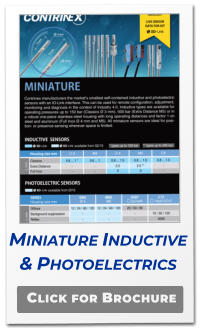

WATCH THE VIDEO TO SEE THE UNIQUE
ROBUSTNESS SURVIVE A HAMMERING



WATCH THE VIDEO TO SEE THE UNIQUE
ROBUSTNESS DEMONSTRATED
WATCH THE VIDEO OF A MINIATURE
PHOTOELECTRIC PREVENT CALCULATOR THEFT
WELCOME TO PLUS AUTOMATION LTD - EXPERTS IN SENSORS,
WE WILL HELP YOU SOLVE YOUR APPLICATIONS, IMPROVE MACHINE
PERFORMANCE & RELIABILITY AND REDUCE COSTS USING CONTRINEX’S
EXCEPTIONAL SENSORS - LET US HELP YOU #MAKE SENSE OF SENSORS



During semi-automated heat staking of assemblies
manufacturers use light curtains to preserve operator safety
without compromising production throughput. The active
optoelectronic protective device (AOPD), mounted directly in
front of each bench-mounted heat-press, prevents the press-
head from descending if it detects any intrusion in the
working area, halting the operating cycle immediately.
CUSTOMER APPLICATION
Heat-staking is a popular process for fastening metal parts to
plastic moldings, and is commonly used by manufacturers
during the production of sub-assemblies. At each station, an
operator loads a molding and one or more metal parts into a
slide-mounted assembly fixture. Once the components are
correctly inserted, the operator pushes the slide into position
beneath the press-head, triggering the automated heat-
staking cycle.
The heated press-head, which may reach temperatures in
excess of 350oC (660oF), descends toward the pre-positioned
components. It applies heat and pressure to specific areas of
the molding, causing a controlled thermal deformation that
creates a permanent joint between the metal parts and the
molding. Following a pre-determined dwell period, the head
returns to the raised position, ending the cycle; the operator
withdraws the slide and removes the assembly from the
fixture.
Existing mechanical safety barriers are cumbersome and
inconvenient; throughput is constrained as a result of the time
taken to open and close the guards during each cycle. The
company requires an alternative safety guard that provides
effective hand protection while allowing unobstructed loading
and unloading. It must be simple, space-saving and operate
reliably in the production environment.
















